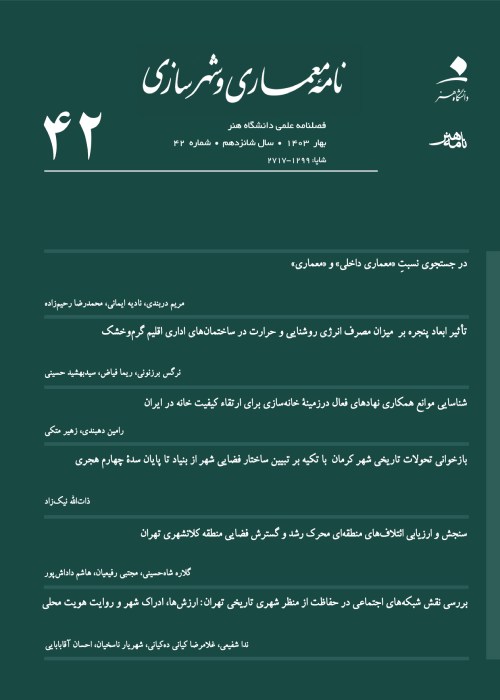Multivariate Analysis of Influence of Neighborhood Design on Travel Behavior Case Study: Ten Neighborhoods in Isfahan
Author(s):
Abstract:
During past decades, concerns over rising fuel prices, climate changes, and congestion have prompted research into the influences of urban form and land-use patterns on travel behavior. Many studies found that residents living in traditional neighborhoods (characterized by high density, high accessibility, mixed land use, rectilinear street network, and so on) drive less and walk more than those living in suburban neighborhoods. This research, which is a correlational study, aims to investigate the factors that affect travel behavior within different neighborhoods in the north of Isfahan. In this regard, 5 old and 5 new neighborhoods have been carefully selected. The old neighborhoods are characterized by organic network with numerous cal-de-sacs and the new neighborhoods characterized by grid network with a few cal-de-sacs. Using a self-administrated questionnaire filled out by 312 respondents as samples, variables of research including perceived characteristics of neighborhoods, travel attitudes, socio-economic characteristics as well as frequencies of non-work trips by different options (walking, auto, and transit) have been captured. To measure the frequencies of home-based non-work trips by auto, walking/biking, and transit, respondents were asked to report how often they use auto, walking/biking, and public transit from their home to particular non-work destinations in a typical month with suitable weather. To measure the attitudes regarding travel and perceived characteristics of neighborhoods, the survey asked respondents whether they agreed or disagreed with a series of statements on a 5-point scale. Since some of the neighborhoods’ characteristics and statements relating to travel attitudes, which measure similar dimensions of the built environment and travel attitudes are highly correlated, a factor analysis is conducted to identify underlying constructs of perceived neighborhood characteristics and travel attitudes. Finally, the perceived neighborhood characteristics were reduced to six factors: proximity, safety, accessibility, socializing, physical activity attractiveness, and outdoor spaciousness. In addition, five factors were extracted from the statements of travel attitudes: pro-bike/walk, pro-transit, travel minimizing, car dependent, and safety of car. The ANOVA tests demonstrate that there are statistically significant differences only in mean motorized trips in different neighborhoods. This finding suggests that residential neighborhood type may be a better predictor for motorized trips than for walking trips. A comparison between perceived neighborhood design characteristics and travel attitudes after normalizing factor scores shows that respondents from the old neighborhoods score significantly higher than those from the new neighborhoods on the factors of safety, socializing, pro-bike/walk, pro-transit, but lower on proximity, accessibility and car dependent. Multivariate analysis of cross-sectional data shows that neighborhood type significantly influences the auto trips. In addition to neighborhoods type, after accounting for socio-economic variables, it can be said that some of the perceived characteristics of urban forms such as proximity, accessibility, and socializing and travel attitude relating to pro-bike/walk, pro-transit, and car dependent have significant relationship with travel behavior. Taken together, our results suggest that if land use policies offer some alternatives to drive less and use transit and non-motorized modes more, many residents will tend to do so.
Keywords:
Language:
Persian
Published:
Journal of Architecture and Urban Planning, Volume:6 Issue: 12, 2014
Page:
61
magiran.com/p1248289
دانلود و مطالعه متن این مقاله با یکی از روشهای زیر امکان پذیر است:
اشتراک شخصی
با عضویت و پرداخت آنلاین حق اشتراک یکساله به مبلغ 1,390,000ريال میتوانید 70 عنوان مطلب دانلود کنید!
اشتراک سازمانی
به کتابخانه دانشگاه یا محل کار خود پیشنهاد کنید تا اشتراک سازمانی این پایگاه را برای دسترسی نامحدود همه کاربران به متن مطالب تهیه نمایند!
توجه!
- حق عضویت دریافتی صرف حمایت از نشریات عضو و نگهداری، تکمیل و توسعه مگیران میشود.
- پرداخت حق اشتراک و دانلود مقالات اجازه بازنشر آن در سایر رسانههای چاپی و دیجیتال را به کاربر نمیدهد.
In order to view content subscription is required
Personal subscription
Subscribe magiran.com for 70 € euros via PayPal and download 70 articles during a year.
Organization subscription
Please contact us to subscribe your university or library for unlimited access!


